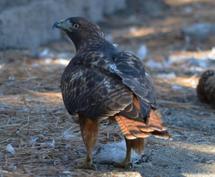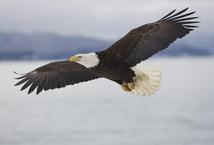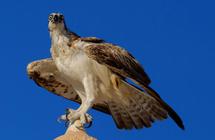saveourplanetearth.com
Call us: (775) 831-1331
Red-Tailed Hawk, Osprey, Bald Eagle
There is a handsome fellow I run into sometimes on my walks and his name is Hoss, so dubbed by the late Bill Bohn; therefore Hoss he shall remain. He is a red-tailed hawk. I may have also known him when he was young as I had a juvenile visiting my bird feeders a couple years back, trying to catch lunch. He was never successful, at least not when I was watching.
One time, though, years ago, my daughter and her little friends happened to be watching out the upstairs window and saw a bird of prey catch a small songbird and proceed to eat it in the driveway. They were horrified, but compelled to watch.
Mostly the hawk eats small mammals, such as mice, rabbits and squirrels, but will also eat spiders, grasshoppers, earthworms and fish. I keep hoping that Hoss will eat those pesky squirrels that keep eating my tulip bulbs…..
I was fortunate to capture this photo of a hawk eating a gull in the parking lot of a Safeway in South Shore. He displayed his signature red tail while guarding his food, staring at me, daring me to try and take his hard-earned meal. What a beauty he is, and large. His wing span is generally around four feet.
He mates in the spring, the female laying two or three eggs in a thick nest high up in a tree or on a ledge. The female primarily incubates the eggs for about a month while the male keeps busy feeding her. They both work to feed the young for six weeks; the young are totally fledged at four months. Red-tailed hawks mate for life, taking another mate only if the other dies.
Another bird that mates for life is the osprey, which can be found around Lake Tahoe in the summer. This bird is distinguished by his white breast, white head, brown wings and a brown stripe through his yellow eyes. He’s an impressive sight soaring overhead with a wingspan of 4-5 feet or more.
Its nest is a large pile of sticks, built in the open on a pole, ledge or dead tree near water. The female lays two to four eggs which are incubated for five weeks. It can take as long as five days for all the hatchlings to emerge and as much as 2 ½ months to fully fledge.
The osprey circles the water, chirping as he hunts, hovering for a moment before diving feet first, to pluck his prize from the water. He has barbed pads on his feet and will orient the fish for optimum aerodynamics as he’s flying to a perch or back to the nest. Unlike other birds of prey, which eat small mammals or insects as well as fish, the osprey eats only live fish.
The osprey is basking in the warmth of Mexico by now but will be back in the spring. Until then, we have the bald eagle to entertain us, which are more prevalent at Lake Tahoe in the winter than in the summer.
The bald eagle, along with several other birds of prey, was endangered and on the brink of extinction back in the 60s, mainly due to the use of pesticides but also because of hunting, electrocution and the loss of habitat. Thanks to the intervention of the government, the eagle has made a tremendous comeback and was removed from the endangered list in 2007.
Its nest is the largest of any bird in North America, measuring as much as 8 feet across and 13 feet deep. The nest is used more than once, added to each year, for up to five years, before its massive weight can no longer be borne by the branches it rests on.
The bald eagle breeds earlier than other raptors, laying typically two eggs in late February to mid-March, hatching from mid-April to early May. The young eagles gain sexual maturity between four and five years of age, at which point they also will display the signature white head and tail. They often return to where they were born to breed.
If only we humans could learn from these large raptors—the bald eagle also mates for life.
Red-tailed Hawk
Photographer: Toree Warfield
Osprey
123rf.com #25755894
Photographer: Mirosław Kijewski
Bald Eagle
123rf #8884364
Photographer: John J Henderson





